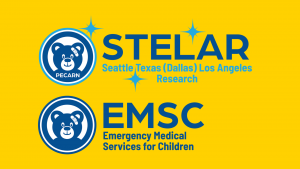Authors: Kayvan Moussavi, PharmD, BCCCP (Clinical Pharmacy Specialist – Emergency Department, Loma Linda, CA) and Bert Matsuo, PharmD (PGY2 – Cardiology, Loma Linda, CA) // Edited by: Alex Koyfman, MD (@EMHighAK) and Brit Long, MD (@long_brit)
Acknowledgements: The authors would like to thank Raymond Ngo, PharmD, BCPS (Clinical Pharmacy Specialist- Emergency Department, Loma Linda, CA), Liz Fierro, MD (Pediatric Emergency Medicine Fellow, Loma Linda University Health), and Natasha Li, MD (Pediatric Emergency Medicine Fellow, Loma Linda University Health) for editing this article.
Case
A 60 y/o, 100 kg male with a past medical history of hypertension, diabetes mellitus, and obesity presents to your emergency department with altered mental status for one day. The patient’s wife states that yesterday he was feeling ill and thought he had the flu. He did not take any of his routine medications yesterday or today. This morning she had trouble waking him up, so she called 911. Upon initial assessment, the patient is pale, tachypnic, and altered (GCS 7).
- Vitals include: BP 88/49, HR 110, RR 27, Sat 90% on RA, T 101.3 F, GCS 7
- Point of care glucose: 179 mg/dL
- Home medications: hydrochlorothiazide, benazepril, metformin
You successfully intubate the patient with etomidate and rocuronium. Chest X-ray suggests the patient has pneumonia, so you order ceftriaxone, azithromycin, and 3 liters of lactated ringer’s. Because the patient appears to be fighting the ventilator, you order fentanyl 50 mcg IV x 1. Thirty minutes later, the nurse states the patient continues to fight the ventilator (RASS+2) and asks for a sedative. The patient’s BP is now 86/45.
What options do you have for sedation in this patient?
Introduction
Propofol, dexmedetomidine, and opioids are commonly used for patients requiring continuous sedation or analgesia, such as for those receiving mechanical ventilation.1 Although these medications are generally safe, some may be unable to tolerate them due to hemodynamic status.2-7
Ketamine is a rapid acting, dissociative anesthetic used frequently in the emergency department for sedation and, more recently, pain relief.8-10 Ketamine use during procedural sedation in the emergency department and perioperative setting has been shown to provide sedation and pain relief without the negative hemodynamic and pulmonary effects of traditional sedatives and analgesics.11-16 These findings suggest ketamine may be an ideal agent for continuous sedation in critically ill patients.
Let’s examine ketamine and the evidence assessing its use as a continuous infusion for critically ill patients. We will focus on high dose (i.e. doses needed to provide continuous sedation) rather than low dose infusion used for depression or pain relief alone.
Ketamine Basics
- Mechanism of action
- Non-competitive N-methyl-D-aspartate (NMDA) receptor antagonist that blocks glutamate, giving rise to a dissociative state. Ketamine may also enhance the pain-relieving effects of the mu opioid receptor and cause other central or peripheral nervous system neurotransmitter alterations that result in analgesia, hyperadrenergic state, or psychosis.8,10,17
- Indications17
- Labeled: Induction and maintenance of general anesthesia.
- Off-label: Sedation/analgesia in critically ill patients, complex regional pain syndrome, refractory depression, refractory status epilepticus, status asthmaticus, rapid sequence intubation, bronchospasm, and restless leg syndrome.
- Benefits17-21
- Rapid onset (1-2 mg/kg IV: 30-40 sec, 4-5 mg/kg IM: 3-4 min, 3-6 mg/kg IN: 8-12 min)
- Short duration (1-2 mg/kg IV: 5-10 min, 4-5 mg/kg IM: 12-25 min, 3-6 mg/kg IN: 45-60 min)
- Predictable dose-response relationship
- Available to be given IV, IM, IN, PO, SC, PR
- Hypotension and respiratory depression appear to be uncommon18,19
- Decreased opioid consumption20
- Possible Adverse Drug Events (ADEs)8,11,17
- Cardiovascular: Hypertension, hypotension, tachycardia, bradyarrhythmia
- Neurologic: Emergence reactions, agitation
- Ophthalmic: Nystagmus
- Immunologic: Anaphylaxis, rash
- Respiratory: Laryngeal spasm, pulmonary edema, apnea, respiratory depression
- Muscular: Hypertonicity, purposeless movement
- Gastrointestinal: Hypersalivation, emesis
- IV Bolus Dosing21
- Adults: 0.5-4.5 mg/kg
- Peds: 0.5-2 mg/kg
How should I dose ketamine if I want to use a continuous infusion?
There have been several recent articles evaluating the use of continuous ketamine infusion for sedation. These articles give us an idea of dosing, efficacy, and safety of ketamine infusion.22-26

To summarize:
- There are currently no large prospective trials examining ketamine continuous infusion use.
- Continuous infusion use has mostly been evaluated retrospectively in critically ill adults and children.
- Ketamine was often used in combination with other sedatives or analgesics.
- Dosing ranged from 0.04 to 4 mg/kg/hr, with one study using up to 10 mg/kg/hr.
- Some patients received ketamine boluses prior to infusion (up to 5 mg/kg for RSE).25
- Ketamine helped achieve sedation goals and decrease opioid use in some studies.22,23,26
- ADEs occurred in up to 13% of patients and were most often tachyarrhythmias (included tachycardia, ventricular tachycardia, supraventricular tachycardia, and atrial fibrillation), delirium, agitation, or emergence reaction.
What if my patient has renal or hepatic dysfunction?
There are no recommended dosing adjustments for hepatic or renal impairment per the package insert.17 However, it is reasonable to start at the lower end of the dosing range and titrate to desired effect if organ dysfunction is present (e.g. 0.25-0.5 mg/kg/hour).
How should I ask the pharmacy to prepare the ketamine drip?
Vials may be further diluted in D5W or NS to prepare an infusion with a final concentration of 1-2 mg/mL.17 There is evidence that ketamine is stable at concentrations up to 25 mg/mL.27 A more concentrated solution would be less likely to contribute to fluid overload, especially in patients with organ dysfunction receiving other IV solutions (e.g. crystalloids, antibiotics, vasopressors, etc.). Our institution prepares ketamine as a 10 mg/mL solution (1000 mg/100 mL NS in adults or 500 mg/50 mL NS in pediatrics).
Case Resolution
Due to the patient’s hypotension, you are hesitant to start propofol or dexmedetomidine. You decide to initiate ketamine continuous infusion at 0.5 mg/kg/hour titrated by 0.25 mg/kg/hr every 30 min to RASS goal -1. You also start norepinephrine at 5 mcg/minute titrated by 2.5 mcg/min every 5 min to MAP 65-70. You bolus ketamine 50 mg IV prior to starting the ketamine drip. Thirty minutes later, the nurse notes the BP is 100/60, HR 91, RASS -1. The patient is then transferred to the ICU. Success!
Take home points
- Ketamine continuous infusion can be considered for adult and pediatric patients that may not tolerate propofol, dexmedetomidine, or opioids.
- Ketamine has analgesic and sedative properties and may be less likely to cause hypotension, bradycardia, or respiratory depression compared to other agents.
- Literature supporting use as a continuous infusion is mostly limited to retrospective studies.
- Ketamine may decrease opioid or other sedative requirements.
- Tachyarrhythmias and psychiatric reactions appear to be the most common ADEs.
- Dosing reported in literature ranges from 0.04-10 mg/kg/hr.
- Ketamine can be prepared as 1000 mg/100 mL NS in adults or 500 mg/50 mL NS in pediatrics.
References / Further Reading:
- Barr J, Fraser GL, Puntillo K, et al. Clinical practice guidelines for the management of pain, agitation, and delirium in adult patients in the intensive care unit. Crit Care Med 2013; 41:263-306.
- Panharipande PP, Pun BT, Herr DL, et al. Effect of sedation with dexmedetomidine vs. lorazepam on acute brain dysfunction in mechanically ventilated patients: the MENDS randomized controlled trial. JAMA 2007; 298(22):2644-2653.
- Riker RR, Shehabi Y, Bokesch PM, et al. Dexmedetomidine vs. midazolam for sedation of critically ill patients: a randomized trial. JAMA 2009; 301(5):489-499.
- Jakob SM, Ruokonen E, Grounds RM, et al. Dexmedetomidine vs. midazolam or propofol for sedation during prolonged mechanical ventilation: two randomized controlled trials. JAMA 2012; 307(11): 1151-60.
- Riker RR, Fraser GL. Adverse events associated with sedatives, analgesics, and other drugs that provide patient comfort in the intensive care unit. Pharmacotherapy 2005; 25(5 Pt2):8S-18S).
- Pisani MA. Considerations in caring for the critically ill older patient. J Intensive Care Med 2009; 24(2): 83-95.
- Jungguist CR, Smith K, Nicely KL, et al. Monitoring hospitalized adult patients for opioid-induced sedation and respiratory depression. Am J Nurs 2017; 117(3 suppl 1):S27-S35.
- Erstad BL, Patanwala AE. Ketamine for analagosedation in critically ill patients. J Crit Care 2016 Oct; 35:145-9.
- Patanwala AE, Martin JR, Erstad BL. Ketamine for analagosedation in the intensive care unit: a systematic review. J Intensive Care Med 2017 Jul; 32(6): 387-395.
- Domino EF. Taming the ketamine tiger. Anesthesiology 2010; 113: 678-86.
- Green SM, Roback MG, Kennedy RM, et al. Clinical practice guideline for emergency department ketamine dissociative sedation: 2011 update. Ann Emerg Med 2011; 57(5): 449-61.
- Schmittner MD, Vajkoczy SL, Horn P, et al. Effects of fentanyl and S (+) – ketamine on cerebral hemodynamics, gastrointestinal motility, and need of vasopressors in patients with intracranial pathologies: a pilot study. J Neurosurg Anesthesiol 2007; 19: 257-262.
- Hopper AB, Vike GM, Castillo EM, et al. Ketamine for acute agitation in the emergency department. J of Emerg Med 2015; 48(6): 712-719.
- Yan JW, McLeod SL, Iansavitchene A. Ketamine-propofol versus propofol alone for procedural sedation in the emergency department: a systematic review and meta-analysis. Academic Emergency Medicine 2015; 22:1003-1013.
- Riddell J, Tran A, Bengiamin R, et al. Ketamine as a first-line treatment for severely agitated emergency department patients. Am J Emerg Med 2017; 35(7): 1000-1004.
- Jabre P, Combes X, Lapostolle F, et al. Etomidate versus ketamine for rapid sequence intubation in acutely ill patients: a multicenter randomized controlled trial. Lancet 2009; 374(9686): 293-300.
- Ketamine [package insert]. Par Pharmaceutical: Chestnut Ridge, NY; 2017.
- Buchheit JL, Yeh DD, Eikermann M, Lin H. Impact of Low-Dose Ketamine on the Usage of Continuous Opioid Infusion for the Treatment of Pain in Adult Mechanically Ventilated Patients in Surgical Intensive Care Units. J Intensive Care Med. 2017;885066617706907.
- Neunhoeffer F, Hanser A, Esslinger M, et al. Ketamine Infusion as a Counter Measure for Opioid Tolerance in Mechanically Ventilated Children: A Pilot Study. Pediatr Drugs. 2017;19(3):259-265.
- Ahern TL, Herring AA, Miller S, Frazee BW. Low-Dose Ketamine Infusion for Emergency Department Patients with Severe Pain. Pain Med. 2015;16(7):1402-9.
- Lexicomp Online®, Lexi-Drugs®, Hudson, Ohio: Lexi-Comp, Inc; April 8, 2018.
- Golding CL, Miller JL, Gessouroun MR, Johnson PN. Ketamine Continuous Infusions in Critically Ill Infants and Children. Ann Pharmacother. 2016;50(3):234-41.
- Groetzinger LM, Rivosecchi RM, Bain W, et al. Ketamine Infusion for Adjunct Sedation in Mechanically Ventilated Adults. Pharmacotherapy. 2017
- Umunna BP, Tekwani K, Barounis D, Kettaneh N, Kulstad E. Ketamine for continuous sedation of mechanically ventilated patients. J Emerg Trauma Shock. 2015;8(1):11-5.
- Gaspard N, Foreman B, Judd LM, et al. Intravenous ketamine for the treatment of refractory status epilepticus: a retrospective multicenter study. Epilepsia. 2013;54(8):1498-503.
- Pruskowski KA, Harbourt K, Pajoumand M, Chui SJ, Reynolds HN. Impact of Ketamine Use on Adjunctive Analgesic and Sedative Medications in Critically Ill Trauma Patients. Pharmacotherapy. 2017;37(12):1537-1544.
- Trissel’s™2 Clinical Pharmaceutics Database. Lexicomp Online [database online]. Hudson, OH: Lexicomp; April 8, 2018.








